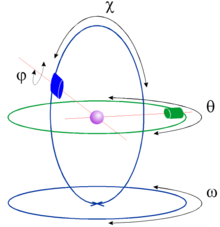Single crystal diffractometer

A single crystal diffractometer (from diffraction , Latin for diffraction ) is a special variant of the X-ray diffractometer for crystal structure analysis . The device measures the diffraction angles and intensities of an X-ray beam on crystals , from which their crystal structure can be determined.
X-ray source
In the laboratory in Einkristalldiffraktometern mostly molybdenum - or copper - anodes used. The X-rays are sent through a monochromator and a collimator so that a primary beam with a characteristic Kα wavelength (molybdenum: 0.71 Å ; copper: 1.54 Å) is created. The doublet present there can be corrected with the help of the Rachinger correction . Other wavelengths are also used at the synchrotron .
In the laboratory, X-ray tubes are used to generate X-rays:
- fixed anode (water-cooled, approx. 2 kW )
- Rotating anode (water-cooled, approx. 3 to 6 kW)
- Microsource (water or air cooled, about 30 W)
A single crystal is placed in the primary beam . This is attached to an amorphous glass or nylon thread or in a glass capillary that sits on a so-called goniometer head, which enables fine adjustment of the crystal in the primary beam. Most of the time, the crystal is additionally cooled by a stream of nitrogen.
Goniostat
Since the reflections depend on the arrangement of the lattice planes of the crystal to the primary ray and occur in all directions of the room, it is necessary to rotate the crystal. This is why all diffractometers have a goniostat that enables these rotations.
Four circle diffractometer
With the four-circle diffractometer, the goniostat has four circles. The best results are achieved when the axis of rotation of the crystal movement is perpendicular to the primary beam.
In Euler geometry ( see also Euler's angle ) the ω-circle rotates in the horizontal plane, the χ-circle in the vertical plane standing on it. In the χ circle sits the goniometer head, which can continue to rotate around its axis, the φ circle. The fourth circle, the θ circle, to which the detector is attached, now rotates in the plane of the ω circle. It is thus possible to measure the position and intensity of each individual reflex. The Cartesian coordinate system of the diffractometer is defined in Euler geometry in such a way that the -axis points from the crystal to the X-ray source, the -axis is horizontal and the -axis is vertical, so that a right-handed system is created.
In Kappa geometry , the χ movement of Euler geometry is replaced by a rotation. The axis forms an angle of 50 ° with respect to . The Kappa geometry has the advantage that, in principle, only the lower half of the sphere is needed, so that the upper half is free, for example to apply nitrogen cooling.
Three circle diffractometer
Three-circle diffractometers are diffractometers in Kappa geometry, which are not rotatable but fixed. In order to obtain a complete data set, it may be necessary to perform crystal rotations in which the axis of rotation is not perpendicular to the primary beam.
Single-circle diffractometer
Single-circle diffractometers are diffractometers in which only the φ-circle can be rotated. If the crystal symmetry is low, it is not possible to measure complete data sets with high resolution.
detector
The following detectors are used in the single crystal diffractometer:
- Point detectors , e.g. B. a counter tube
- Area detectors, such as CCD detectors , x-ray sensitive image plate ( English imaging plate ), etc.
Point detectors
If the detector consists of a counter tube ( scintillation counter ), each reflex must be measured individually. However, since a crystal usually produces a five-digit number of reflections, this process is relatively time-consuming. Point detectors are therefore used almost exclusively with four-circle diffractometers.
Area detectors
With the area detector, several reflections are recorded at the same time. The crystal is rotated through a small angle (0.3-2.0 °) and exposed while rotating. Then the signal is read out and the crystal is rotated again by a small angle. Area detectors are built into four-, three- and single-circle diffractometers.
The CCD detector works like a digital camera, here X-rays are converted into light by means of a fluorescent layer, which the CCD can detect or a CCD detector that is sensitive to the X-ray spectrum is exposed directly. The CCD detector enables quick measurements with measurement times from a few seconds to minutes. However, their detector area is relatively small, so not all reflections can be measured.
An X-ray sensitive imaging plate is a round imaging plate made of organic material coated with barium bromofluoride (BaBrF) doped with europium ions (Eu 2+ ) . If an X-ray quant hits the plate, a photo-induced oxidation to Eu 3+ takes place at this point . A color center is created with a half-life of around 10 hours. After exposure, the plate is read by a laser and then erased with bright halogen light. Such image plates need up to one hour per (partial) image, depending on the exposure time, but plate diameters of up to 35 cm are possible.
A great deal of development is taking place in the area of area detectors in order to be able to measure faster and / or to obtain a better signal-to-noise ratio . Today, CMOS chips can also be used in detectors.
literature
- L. Spiess, R. Schwarzer, H. Behnken, G. Teichert: Modern X-ray diffraction . Springer, 2015, ISBN 978-3-663-10831-3 , pp. 203 ( limited preview in Google Book search).
Web links
Individual evidence
- ↑ Ludwig Bergmann, Clemens Schaefer, Rainer Kassing: Textbook of Experimental Physics 6. Solid . Walter de Gruyter, 2005, ISBN 978-3-11-017485-4 , p. 171-174 .





